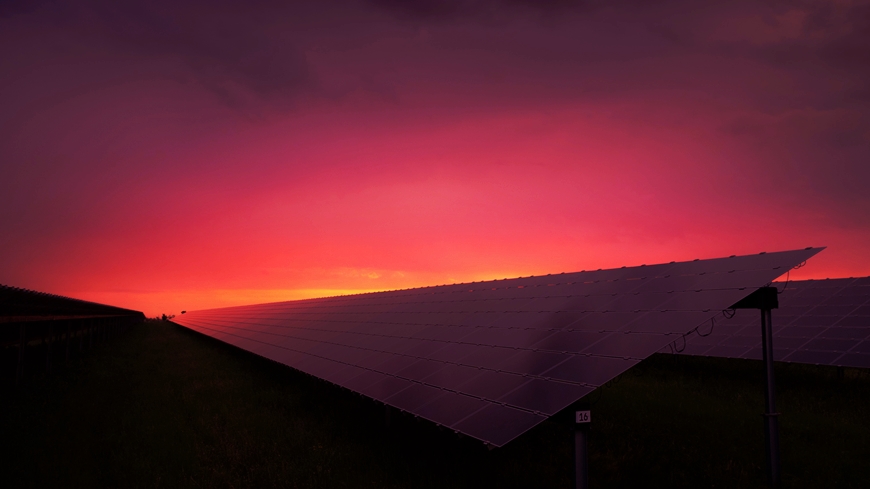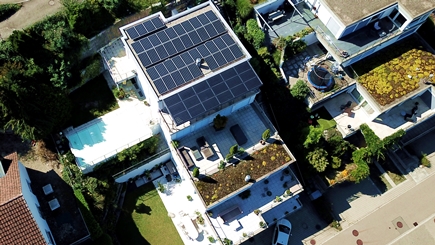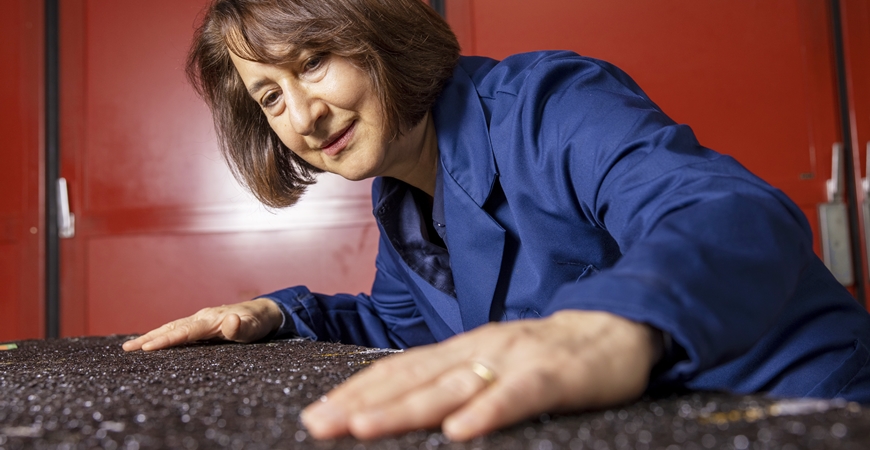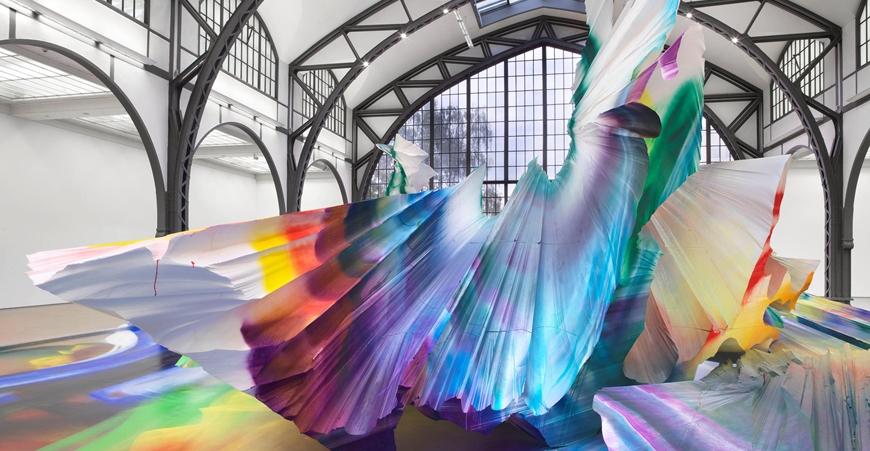Interview
Living in the crystal ball
Alain Aerni is trying to look into the future: His "Crystalball" energy control system combines photovoltaics, heat pumps and charging stations and uses weather reports to predict energy requirements. In late 2020 he presented his system at an event at the Empa Akademie.

Mr. Aerni, you are an engineer and have optimized the energy efficiency of your own residential building, which is 20 years old. Your company Soleco now offers this service to other homeowners. What idea should one start with if one wanted to start a project like this?
It always starts with the costumer's needs. The first step is to determine the heating requirements of the house. What do I need to achieve a room temperature of 22 degrees Celsius throughout the year? What is my hot water consumption? Do I want to charge one or two electric cars in the garage, and how many kilometers do I want to drive each day?
Do I need a storage battery if I want to charge an electric car?
If you want to use solar energy in your home particularly economically, you should currently still do without a storage battery. So if you have days with home office, you can charge the electric car on these days and drive with it the next day. Only those who are always on the road during the day and at the same time want to charge their cars with their own solar power will not be able to do without a storage battery.
What else does the customer need to consider?
The important question is how long you intend to stay in your home. The time horizon influences the choice of components. There are long-lasting components, such as a geothermal probe – a very efficient system for heating a house. Those are designed for 50 years of use, but it also takes decades to pay for itself. For customers who only want to plan ahead ten to 15 years, I'd rather recommend an air-to-water heat pump.
And if I know my heating requirements and my time horizon, then I'm ready to go?
(smiles) Not quite yet. Now the noise factor comes into play. If you use an air-source heat pump and run it on solar power from your rooftop, that's very efficient. But such a system makes noise and can disturb the neighbors. If you have a single-family house with a lot of surrounding area, this is not a problem. For a large apartment building, you need bigger machines: bigger fans, bigger compressors. In a tightly built neighborhood, that becomes difficult.

The building authorities might not approve it?
That's right. You have to comply with the official threshold values. Fortunately, there are also so-called split units: Here, only the evaporator and the fan are mounted outside, the compressor is installed in the house. These units are quieter.
So you have to have an advisor to guide you through the offers that are on the market.
Yes, but you shouldn't just think about the heat pump, you should think about the whole system from the start: the heat pump, the size of the photovoltaic system, the hot water storage tank, the electric car charging station, the blinds for the shading and, if necessary, the storage battery. After all, you want to control everything together so that everything works together smoothly. The components you buy must therefore be able to communicate with the central control system.

Is there no "plug-and-play", no common standard?
We are not far enough yet. There is, for example, a common standard for the control of heat pumps, the "SG Ready Label". But this does not cover all the functionalities that are necessary for a good system. The SG Ready Label needs to be developed further. We are working with partners to propose a common standard. But at the same time, there are more and more manufacturers who are sealing off their systems from the outside in order to expand their market share.
How much networking makes sense? Is it possible to overdo it?
If you want to be efficient, you have to keep an eye on the major consumers: Heating, hot water demand, electro-mobility and storage battery. It's not important when the washing machine or the tumble dryer are running. They can be switched on manually. What is important, however, is taking solar radiation into account. Our control system "Crystalball" (see box) can predict the heating on sunny days and the heat loss on cold days with the help of the weather report, and thus use the heat pump more economically and in a more targeted way.
Alain Aerni
BORN: 3 May 1960 in Moudon /VD
EDUCATION: Dipl. Ing. EPFL and Master in Science of Management at Massachusetts Institute of Technology (MIT)
PROFESSION: Founder and CEO of Soleco AG, Maur/ZH
AWARD: Digital Journey Award 2018 of the Centre d'Electronique et de Microtechnique (CSEM) for the development of a platform for the management of renewable energies in buildings
You also have been cooling your home with your own solar power since the refurbishment. You converted your 20-year-old radiant floor heating system to radiant floor cooling. Is it that simple?
You don't even have to convert anything. It's just important that the water running through the floor isn't too cool. So you need an adjustable heat pump, the output of which matches the area you want to cool.
How big should the photovoltaic system on the roof be? Is it possible to exaggerate?
There is certainly an optimum that fits the energy system of the house. If you cover your entire roof with photovoltaics, you are certainly above that. But there is nothing wrong with that.
Why?
Think about the neighbors. You could supply electricity within your neighborhood to others who don't yet have photovoltaics. And think about the national energy supply. In winter, when the sun is flat, we're glad for every bit of solar power we can feed into the grid. In future, we can also produce hydrogen from surplus electricity. Of course, that's not worthwhile in a single family home. But at some point, there will be suppliers who will buy the electricity from homeowners in the summer and convert it into hydrogen.
Well, then we're perfectly prepared for the energy transistion!
Well, there is still a conflict: Some electricity suppliers would like to use blocking periods to control devices with rather large energy requirements – for example heat pumps and charging stations – in such a way that the load on the grid is reduced. This means that you may not be able to start up your heat pump just when you are producing the most electricity with your photovoltaics. You would then have to sell the electricity to the electricity supplier at a very low rate. In this case, electricity suppliers optimize their profits at the expense of homeowners.
But central control is necessary to ensure grid stability, isn't it?
As a homeowner, I clearly don't want that. And it's not necessary either.
How would you solve the problem?
With my control system, I can contribute to a stable power grid without anyone having access from the outside. My system is set to optimize costs. The electricity supplier only has to tell me the variable tariffs – preferably eight or even 24 hours in advance, then "Crystalball" will automatically use the heat pump and other electricity consumers in the right way.
This building we're sitting in is a considerable energy store: Each degree of temperature in the walls means 74 kilowatt hours of energy. If the electricity tariff is high tonight, and it's low right now, I'll heat a few hours ahead and not again tonight – and have effectively relieved the load on the power grid. Still, it's nice and warm in the house. So all we have to do is communicate tariffs and let the market play its part, and then each homeowner can retain sovereignty over his or her domestic installations. And the energy transition will still succeed.

Recycling
With a pinch of rubber
Swiss drivers wear out countless tires. Instead of incinerating them, they could be reused locally: The asphalt of various countries has long contained rubber from used tires. Empa and its partners from industry are adopting this idea for potential applications in Switzerland.
>>>>

Optics
Molecules in collective ecstasy
When fluorescent dye molecules nestle perfectly together, something completely new is created: an excited state distributed over many molecules. Such collective excitations can be used in a variety of ways – for organic solar panels, in sensors, for ultrafast data transmission or in microscopy, for example. Empa researchers, together with colleagues from ETH Zurich, EPFL, the Paul Scherrer Institute (PSI) and IBM Research Zurich, have succeeded in making such chemical light amplifiers ten times more efficient than before.
>>>>

Chemical contamination
Detoxifiers from the landfill
Bacteria from an Indian landfill could help eliminate contaminated chemicals. The focus is on pesticides such as lindane or brominated flame retardants, which accumulate in nature and in food chains. Researchers at Empa and Eawag used these bacteria to generate enzymes that can break down these dangerous chemicals.
>>>>






